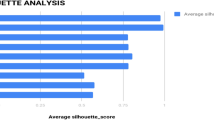Abstract
Various wireless sensors and devices keep collecting data for their environments or owners. Such collected data are given in the form of spatio-temporal sequence data which are a sequence of data elements with spatial information and timestamp. Data clustering is useful in finding inherent underlying structures, natural or interesting groups in a collection of data. This paper proposes a new clustering method for spatio-temporal sequence data with respect to density and frequency. Density is a notion about how densely data elements are in a local region, and frequency is a notion about how many times sequences pass through a local region. The proposed method identifies three types of clusters: high density and high frequency clusters, high density and low frequency clusters, and low density and high frequency clusters. It first augments the data set by inserting dummy data elements for capturing frequency distribution in sparse local regions. Then it computes the densities and frequency for data elements and the frequencies for dummy data elements. It partitions data elements into the high density-high frequency data set, high density-low frequency data set, and low-density-high frequency data set. It clusters each data set individually using the clustering procedures that are similar to DBSCAN, which is a density-based clustering algorithm. The proposed method had been applied to the six spatial–temporal GPS sequence data sets for wildlife movements. The experiment results were compared with the results from DBSCAN and analyzed in terms of the number and characteristics of discovered clusters.






Similar content being viewed by others
References
Kisilevich, S., Mansmann, F., Nanni, M., & Rinzivillo, S. (2009). Spatio-temporal clustering: A survey (pp. 855–874). Berlin: Springer.
Ren, S. S., & Park, J. S. (2009). Fault-tolerance data aggregation for clustering wireless sensor network. Wireless Personal Communications, 51, 179–192.
Wang, Q. (2016). Data forwarding based on node moving trajectory in mobile social networks. Wireless Personal Communications, 87, 1285–1297.
Lee, K. M., & Lee, K. M. (2011). Fuzzy technique-based identification of close and distant clustering in clustering. International Journal of Fuzzy Logic and Intelligent Systems, 11(3), 165–170.
Awwad, S. A. B., Ng, C. K., Noordin, N. K., & Rasid, M. F. A. (2011). Cluster based routing protocol for mobile nodes in wireless sensor network. Wireless Personal Communications, 61, 251–281.
Son, S. H., Seo, S. T., & Kwon, S. H. (2004). Nearest neighbor and validity-based clustering. International Journal of Fuzzy Logic and Intelligent Systems, 4(3), 337–340.
Lee, K. M., & Lee, K. M. (2011). Medoid determination in deterministic annealing-based pairwise clustering. International Journal of Fuzzy Logic and Intelligent Systems, 11(3), 178–183.
Fu, J.-S., Liu, Y., & Chao, H.-C. (2015). ICA: An incremental clustering algorithm based on OPTICS. Wireless Personal Communications, 84(3), 2151–2170.
Jain, A. K. (2010). Data clustering: 50 years beyond K-means. Pattern Recognition Letters, 31, 651–666.
Han, J., & Kamber, M. (2006). Data mining: Concepts and techniques. San Francisco: Elsevier.
Iglesias, F., & Kastner, W. (2013). Analysis of similarity measures in times series clustering for the discovery of building energy patterns. Energies, 6, 579–597.
Vlachos, M., Hadjieleftheriou, M., Gunopulos, D., & Keogh, E. (2003). Indexing multidimensional time-series with support for multiple distance measures. In Proceedings of the ninth ACM SIGKDD international conference on knowledge discovery and data mining (pp. 216–225). New York, NY: ACM.
Kang, J., & Yong, H.-S. (2010). Mining spatio-temporal patterns in trajectory data. Journal of Information Processing Systems, 6(4), 521–536.
Gudmundsson, J., & van Kreveld, M. (2006). Computing longest duration flocks in trajectory data. In Proceedings of the 14th annual ACM international symposium on Advances in geographic information systems (pp. 35–42). New York, NY: ACM.
Vieira, M. R., Bakalov, P., & Tsotras, V. J. (2009). On-line discovery of flock patterns in spatio-temporal data. In Proceedings of the 17th ACMSIGSPATIAL international conference on advances in geographic information systems (pp. 286–295). New York, NY: ACM.
Jeung, H., Yiu, M. L., Zhou, X., Jensen, C. S., & Shen, H. T. (2008). Discovery of convoys in trajectory databases. Proceedings of the VLDB Endowment, 1(1), 1068–1080.
Kang, J. H., Welbourne, W., Stewart, B., & Borriello, G. (2004). Extracting places from traces of locations. In Proceedings of the 2nd ACM international workshop on wireless mobile applications and services on WLAN hotspots (pp. 110–118). New York, NY: ACM.
Palma, A. T., Bogorny, V., Kuijpers, B., & Alvares, L. O. (2008). A clustering-based approach for discovering interesting places in trajectories. In Proceedings of the 2008 ACM symposium on applied computing (pp. 863–868).
Giannotti, F., Nanni, M., Pinelli, F., & Pedreschi, D. (2007). Trajectory pattern mining. In Proceedings of the 13th ACM SIGKDD international conference on knowledge discovery and data mining (pp 330–339) ACM.
Guttman, A. (1984). R-trees: A dynamic structure for spatial searching. In Proceedings of 1984 ACM SIGMOD (p. 47).
Movebank. www.movebank.org. Accessed March 1, 2016.
Acknowledgements
This research was supported by Basic Science Research Program through the National Research Foundation (NRF) of Korea (Grant no.: 2015R1D1A1A01061062).
Author information
Authors and Affiliations
Corresponding author
Rights and permissions
About this article
Cite this article
Lee, K.M., Lee, S.Y., Lee, K.M. et al. Density and Frequency-Aware Cluster Identification for Spatio-Temporal Sequence Data. Wireless Pers Commun 93, 47–65 (2017). https://doi.org/10.1007/s11277-016-3937-x
Published:
Issue Date:
DOI: https://doi.org/10.1007/s11277-016-3937-x




